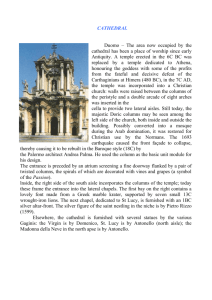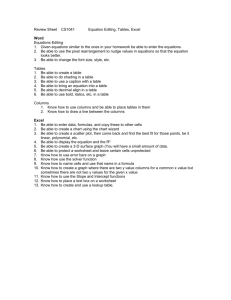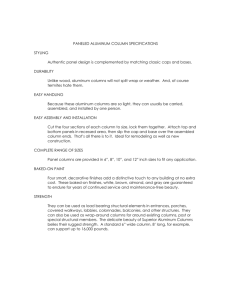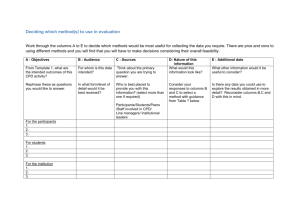Notes for Quizzes
advertisement
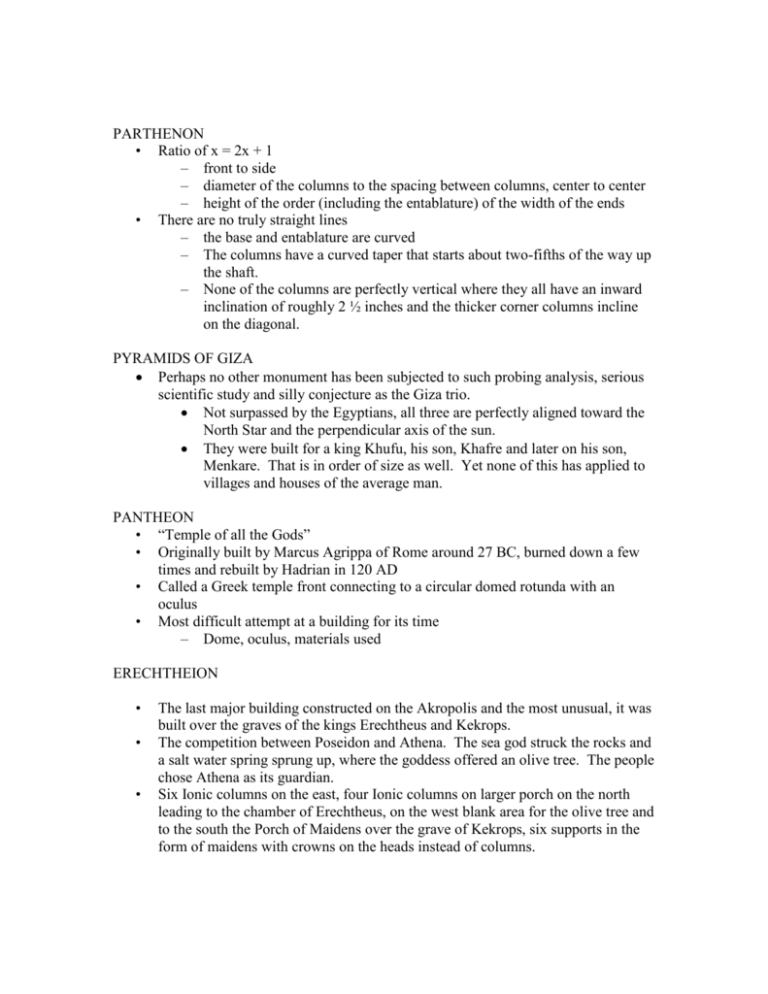
PARTHENON • Ratio of x = 2x + 1 – front to side – diameter of the columns to the spacing between columns, center to center – height of the order (including the entablature) of the width of the ends • There are no truly straight lines – the base and entablature are curved – The columns have a curved taper that starts about two-fifths of the way up the shaft. – None of the columns are perfectly vertical where they all have an inward inclination of roughly 2 ½ inches and the thicker corner columns incline on the diagonal. PYRAMIDS OF GIZA Perhaps no other monument has been subjected to such probing analysis, serious scientific study and silly conjecture as the Giza trio. Not surpassed by the Egyptians, all three are perfectly aligned toward the North Star and the perpendicular axis of the sun. They were built for a king Khufu, his son, Khafre and later on his son, Menkare. That is in order of size as well. Yet none of this has applied to villages and houses of the average man. PANTHEON • “Temple of all the Gods” • Originally built by Marcus Agrippa of Rome around 27 BC, burned down a few times and rebuilt by Hadrian in 120 AD • Called a Greek temple front connecting to a circular domed rotunda with an oculus • Most difficult attempt at a building for its time – Dome, oculus, materials used ERECHTHEION • • • The last major building constructed on the Akropolis and the most unusual, it was built over the graves of the kings Erechtheus and Kekrops. The competition between Poseidon and Athena. The sea god struck the rocks and a salt water spring sprung up, where the goddess offered an olive tree. The people chose Athena as its guardian. Six Ionic columns on the east, four Ionic columns on larger porch on the north leading to the chamber of Erechtheus, on the west blank area for the olive tree and to the south the Porch of Maidens over the grave of Kekrops, six supports in the form of maidens with crowns on the heads instead of columns. “TEMPLE OF ABU SIMBEL” • First monument built into the side of a mountain, in 1264 BC by Ramesses II as a tribute to his alleged victory over the Nubians. • He and his most famous wife, Nefertari, had their heads with the bodies of their gods: Amun Ra, Ra Harakhti and Ptah. FLAVIAN AMPHITHEATRE • Completed in 80 AD under Roman emperor Titus, but started by Vespasian • Used for dramas, gladiatorial contests, executions, animal hunts, war reenactments including ones at sea. • Four level of columns to represent orders – Doric, Ionic, Corinthian, Corinthian pilasters PROPYLEA • Means “front gate” • Built by Mnesicles under the direction of Pericles (23 times) As one entered the Propylaia, you were introduced to “the Champion” Athena Promachos. • There are five gates – one for the central passageway, ground, – two on either side at the level of the building. – The central passageway was the culmination of the Sacred Way, which led to the Acropolis PYRAMID OF ZOSER One successful and abrupt revolution in Egyptian Architecture occurred with the creation of a tomb complex by Imhotep. Around 2750 BC, he substituted limestone for the mud brick, bundled reeds, and tree trunks that had been used in royal buildings up to that time. Standing 197 feet high, it is one of the best known examples of a stepped pyramid. ROMAN BATHS • Early baths generally had dressing room suites and bathing chambers with hot- , warm- , and cold-water baths alongside an exercise area. • Later, baths became progressively grander, incorporating libraries, lecture halls, and vast vaulted public spaces elaborately decorated with statues, mosaics, and paintings. TEMPLE OF ATHENA NIKE One temple, small as it may be, was dedicated to the goddess Athena Nike, the goddess of victory. its small size was compensated for in its position, resting on a rocky outcrop It is the first element of the Akropolis. On the front were four delicate Ionic columns on each end which is in contrast of the Propylaia with its Doric columns. MAISON CARREE • Built in about 19-20 B.C. by Marcus Vipsanius Agrippa of Rome, the name is French meaning 'Squared House' • The façade is dominated by a deep portico or porch, almost a third of the building's length. • It is a pseudoperipteral hexastyle design with six Corinthian columns and twenty engaged columns embedded along the walls of the cella OLD ST. PETER’S BASILICA • Constantine, King of Roman and “first” noteworthy Christian. • Lasted from 326 – 1544 • Consisted of five aisles, a wide central nave and two smaller aisles to each side • The nave ended with an arch, which held a mosaic of Constantine and Saint Peter SAN VITALE • 526-547 in Ravenna, Italy, unknown architect • Dome, arched doorways, stepped towers combined with polygonal apse, capitals and narrow bricks • Octagonal Plan • Mosaics of stories from the Bible HAGIA SOPHIA • First a basilica, then a mosque, now a museum • Combines the central focus of domed Roman buildings with directional focus of Roman basilicas • Dome’s weight is transmitted to a series of half domes and barrel vaults, and bulky buttresses at the corners

